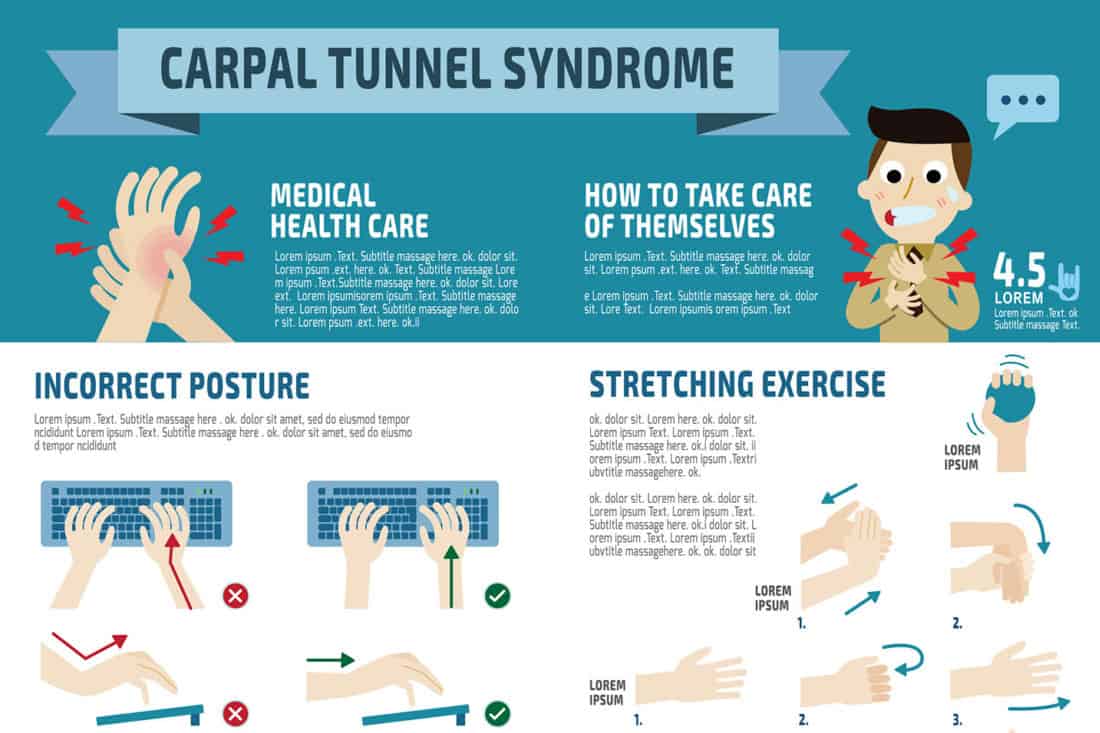Do you know that carpal tunnel syndrome is one of the most common conditions causing numbness, pain and tingling in your hands as well as in your arms? Well, this is a common condition that happens when one of the major nerves present in the hand, i.e. the median is compressed or squeezed as it travels through the wrist.
Now for most patients, the carpal tunnel syndrome will get worse over time. In such cases early treatment as well as diagnosis is necessary. Previously, the symptoms can be relieved using simple measures like avoiding certain activities or wearing a wrist splint.
If pressure is made on the median nerve and if it continues, then it can lead to nerve damage as well as worsening of symptoms. So, one needs to prevent the permanent damage, and, in such cases, surgery is a good choice as it can take out the pressure of the median nerve. Surgery is only recommended for certain patients.
Anatomy of Carpal Tunnel Syndrome
Unlike other medical syndrome, the carpal tunnel is different. This is a narrow passageway in the wrist, and that too above an inch wide. The sides and floor of the tunnel is formed using the small wrist bone which is called as carpal bones. Here the roof of the tunnel will be somewhat a strong band of connective tissue. These are known as transverse carpal ligament. Since the boundaries are quite rigid, the carpal tunnel will end up having less capacity to increase in size or stretch.
Frankly, the median nerve is one of the major nerves in the human hand. This originates like a group of nerve roots present in the neck. Now these roots will come together to create a single nerve in the arm.
Here you need to keep in mind that the median nerve will go down the arm and forearm. It will pass through the carpal tunnel at the wrist. After that it will go into the hand. These are the major nerves that provide feeling in the thumb and index, middle, and ring fingers. Furthermore, the nerve even controls the muscles around the base of the thumb. Also, the nine tendons that bend the fingers and thumb also travel through the carpal tunnel. These tendons are called flexor tendons.
Description
The carpal tunnel syndrome only happens when the tunnel gets narrowed. Sometimes it occurs when tissues surrounding the flexor tendons start to swell. Hence, this puts extensive pressure on the median nerve. Moreover, these tissues are called the synovium. Now most of the time, the synovium will lubricate the tendons. This will make it easier for you to move your fingers.
At times, there is a chance that the synovium might swell. It will end up taking space in the carpal tunnel and, over time, crowds the nerve. This is an abnormal pressure. Which will affect the nerve resulting in pain, numbness, tingling, and weakness in the hand.
In most cases carpal tunnel syndrome can be caused by the combination of various factors. Various studies and research display that women and older people are more likely to suffer from this condition.
Various Other Risk Factors Related to Tunnel Syndrome
The following are some of the risk factors associated with carpal tunnel syndrome-
- Repetitive Use of The Hand use – Repeating using the same hand and wrist motions or activities over a prolonged period will seriously aggravate the tendons in the wrist. It will also cause swelling that will put pressure on the nerve.
- Health conditions – Diabetes, rheumatoid arthritis, and thyroid gland imbalance are conditions that are commonly associated with carpal tunnel syndrome.
- Heredity – This is an important factor. Sometimes the carpal tunnel might be smaller in some people. There might be various anatomic differences that can change the amount of space for the nerves. Now these traits can run in families.
- Pregnancy – Hormonal changes while being pregnant can cause extensive swelling.
- Hand and wrist position – Sometimes doing activities involving extreme flexion or extension of the hand and wrist for a prolonged period will lead to increased pressure on the nerve.
Diagnosing Carpal Tunnel Syndrome
The first step is the diagnosis by your doctor. The doctor will discuss your symptoms and medical history. Then he or she will examine you. Next, various tests will be done like the ones mentioned below:
- Tinel’s sign – In this test, the physician will tap over the median nerve at the wrist. This is to check out if it produces a tingling sensation in the fingers.
- X-rays – Sometimes the X-ray of the wrist will be ordered. This is only done when there is limited wrist motion, or evidence of arthritis or trauma.
- Wrist flexion test (or Phalen test) – Now in this test, the patient will just rest his or her elbows on a table Then he or she will allow the wrist to fall forward freely. In this case, Individuals who are suffering from carpal tunnel syndrome will experience certain kind of numbness and tingling in the fingers within 60 seconds. Here the more quickly symptoms appear, the more severe will be carpal tunnel syndrome.
- Electromyography (EMG) and nerve conduction studies – Such kind of studies will determine how well the median nerve itself is working. It will even show how well one controls muscle movement.
Symptoms of Carpal Tunnel
The following are the symptoms of carpal tunnel syndrome
- Numbness, tingling, burning, and pain: This is primarily in the thumb and index, middle, and ring fingers.
- Weakness and clumsiness in the hand: Here this may make it difficult for one to perform fine movements such as buttoning your clothes.
- Pain or tingling: This will may travel up the forearm toward the shoulder
- Occasional shock: Most of the time you might have to go through this kind of sensations that radiate to the thumb and index, middle, and ring fingers
- Dropping things: This is will happen due to weakness, numbness, or a loss of proprioception (awareness of where your hand is in space)
In most cases, you need to keep in mind that the symptoms of carpal tunnel syndrome begin gradually. This is without having any kind of specific injury. Most of the time various patients find that their symptoms will come and go at first. But, as the condition worsens, the symptoms will happen more frequently or may persist for a longer period.
Keep in mind that the night-time symptoms are very much common. Since there are many people who sleep with their wrists bent, this symptom might awaken you from sleep. Sometimes during the day, these symptoms will often happen when you are holding something for a prolonged period. This is especially when the wrist bent forward or backward. Most commonly is using a phone, driving, or reading a book. Now various patients find that moving or shaking their hands helps them to relieve their symptoms.
Doctor Examination
The doctor’s examination consists of
1) Physical Examination
While examining, your doctor will talk to you about your general health and medical history and will ask more about your symptoms.
He or she will carefully start to examine your hand and wrist and perform several physical tests. So, during these tests, your doctor might:
- Press down or tap along the median nerve at the inside of your wrist to see if it causes any numbness or tingling in your fingers (Tinel sign)
- Bend and hold your wrists in a flexed position for testing any kind of numbness or tingling in your hands
- Testing sensitivity in your fingertips and hands by lightly touching them with a special instrument when your eyes are closed.
- Checking for weakness in the muscles around the base of your thumb
- Looking for atrophy in the muscles around the base of your thumb. In most of the cases, these muscles may become visibly smaller.
2) Tests
Electrophysiological tests: These tests will assist the doctor to measure how well your median nerve is working Also, it will even help in determining whether there is too much pressure on the nerve. Such kind of tests will also help your doctor determine if you have another nerve condition, like neuropathy, or other sites of nerve compression that might be contributing to your symptoms.
Now the electrophysiological tests may include:
- Nerve conduction studies: These kinds of tests will measure the signals travelling in the nerves of your hand and arm. It will even detect when a nerve is not conducting its signal effectively. Also, the nerve conduction studies can assist your doctor and determine how severe your problem is and help to guide treatment
- Electromyogram (EMG): An EMG measures the electrical activity in muscles. This EMG results will easily show whether you have any nerve or muscle damage.
- Ultrasound: An ultrasound uses high-frequency sound waves to help create pictures of bone and tissue. Sometimes your doctor might recommend an ultrasound of your wrist to evaluate the median nerve for signs of compression.
X-rays: X-rays will provide images of dense structures, like the bone. If you have limited wrist motion or wrist pain, your doctor might sometimes order x-rays to exclude other causes for your symptoms, which can be like arthritis, ligament injury, or a fracture.
Magnetic resonance imaging (MRI) scans: These scan and studies will provide better images of the body’s soft tissues. There might be a chance that your doctor may order an MRI to help determine other causes for your symptoms. It might be even to look out for abnormal tissues that impact the median nerve. An MRI can also help your doctor determine if there are problems with the nerve itself—such as scarring from an injury or tumour.
Treatment
Although it is a gradual process, for most people the carpal tunnel syndrome will worsen over time without some form of treatment. For this reason, it is important to be evaluated and diagnosed by your doctor early on. In the early stages, it may be possible to slow or stop the progression of the disease.
Nonsurgical Treatment
If diagnosed and treated early, the major symptoms of carpal tunnel syndrome can often be relieved. And that too without doing any kind of surgery. If your diagnosis is uncertain or if your symptoms are mild, your doctor might recommend nonsurgical treatment first.
The nonsurgical treatments might include:
- Bracing or splinting: Sometimes wearing a brace or splint at night will keep you from bending your wrist while you sleep. Also keeping your wrist in a straight or neutral position reduces the extensive pressure on the nerve in the carpal tunnel. It may also help to wear a splint during the day when doing activities that aggravate your symptoms.
- Nonsteroidal anti-inflammatory drugs (NSAIDs): There are medications like ibuprofen and naproxen which can help relieve pain and inflammation.
- Activity changes: These symptoms will often happen when your hand and wrist are in the same position for too long—particularly when your wrist is flexed or extended.
If your job or recreational activities aggravate your symptoms, changing or modifying these activities can help slow or stop progression of the disease. In some cases, this may involve making changes to your worksite or workstation.
- Nerve gliding exercises: Some patients may benefit from exercises that help the median nerve move more freely within the confines of the carpal tunnel. Specific exercises may be recommended by your doctor or therapist.
- Steroid injections: Corticosteroid, or cortisone, is a powerful anti-inflammatory agent that can be injected into the carpal tunnel. Although these injections often relieve painful symptoms or help to calm a flare up of symptoms, their effect is sometimes only temporary. A cortisone injection may also be used by your doctor to help diagnose your carpal tunnel syndrome.
Surgical Treatment
Sometimes the nonsurgical treatment won’t relieve your symptoms after a period. In this case your doctor may recommend surgery.
Now the decision whether to have surgery is based on the severity of your symptoms. This is based on how much pain and numbness you are having in your hand. In short, if it is a long-standing cases with constant numbness and wasting of your thumb muscles, surgery may be recommended to prevent irreversible damage.
Conclusion
Carpal tunnel syndrome is a serious medical disease. But it can be cured if one takes extensive precaution and do good amount of exercises.




